Going electric: e-bike case studies
Here’s a selection of e-bike case studies that accompany our e-bike buyers guide in Renew 151.
Love at first sight
Bike: Giant 2017 Quick-E+, Pedelec, 3 assistance levels, purchased June 2018, $3999
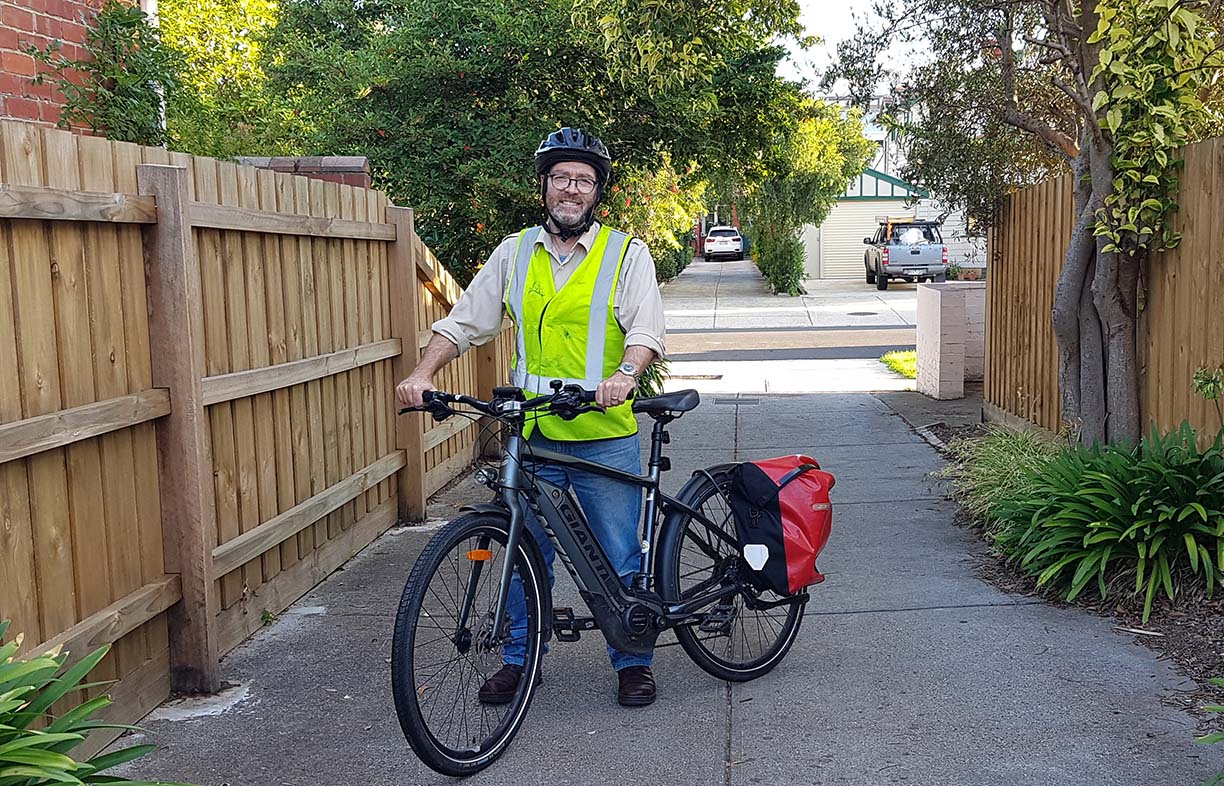
Drew Boucher has been riding to work (on a conventional bike), around 10 km each way, for the past 20 years. It’s a reasonable commute, taking about 50 minutes, and there are a few hills involved, so over the last couple of years as he reached his mid-50s, he found he was getting really tired by the end of the week. He wanted to “stay on the bike” though, so in June 2018 he went looking for an e-bike. “It was love at first sight!”—and he’s been riding the e-bike to work almost every day since.
He’s found the e-bike definitely takes the effort out of the ride—he’s no longer tired at the end of the week—and it’s also taken 10 minutes off his commute time. He uses high power (‘power’ level assistance) on the hills and the middle level (‘normal’) on the flat. Apart from making the commute an enjoyable experience again, the e-bike really proves its worth when there’s a headwind—the prevailing wind direction on his ride to work.
He gets about four to five 20 km commutes out of a full battery charge. He has occasionally “misjudged the charging” and run out of charge just before getting home. “Riding a kilometre or so without power assist is fine, but it’s not something I’d do by choice. The motor provides quite a bit of resistance to pedalling: it’s like riding into a strong headwind.” It takes about four hours to recharge the battery from flat.
To purchase the bike, he looked online and visited bike shops. It took him a while to find the right bike. “The bikes I tried first felt too big or not the right shape. It was always going to be a big investment so I wanted it to be right.” He notes that it was (and still is) a time of rapid change in batteries, motors and cost, so he felt confident that the right bike would come along—which it did. “When I took this bike out for a ride, I knew it was ‘the one’.”
Are there any negatives? He has noticed that his legs aren’t as strong as they used to be, though it’s not a major problem. He recently did the Great Victorian Bike Ride with his family (on his conventional bike) and training was required to build up his “pushbike legs” again. For a few months before the ride, he reduced his reliance on the power assistance, dialling it down to ‘eco’ (the lowest level) or ‘normal’, and did longer weekend rides with his family on his conventional bike.
Maintenance is more expensive than for his conventional bike. For example, when he had a puncture (he’s had one puncture since getting the bike), he had to book it in for fixing—”though that’s partly because my own bike tech skills are low!”
There are two things he’d change if he could, but neither are dealbreakers. One is the way gear changing works: “The supplier recommends you stop pedalling when changing gears for a smoother ride. If I keep pedalling it’s a bit noisy, but I’m used to it now.” The second is the noise from the motor, but he notes that it’s not as noisy as some he’s tried and “it hasn’t stopped me from enjoying it.”
Finally, he says: “Do your homework. There’s an e-bike out there for you, and once you go electric you’ll never look back!”
Brisbane to Fremantle
Bike: Cleverley Premium Ladies e-bike, Pedelec, 5 assistance levels, purchased January 2019, $2299 (www.cleverley.com.au)

Angeline Deo tried her first e-bike when she started work at Bicycle Queensland. BQ offers e-bike programs, allowing anyone to come in and test ride e-bikes including commuting, leisure, compact and mountain bikes. “As an initiation to the team I was taken on an e-bike ride around Brisbane. To be honest I was a little hesitant at first. I thought as soon as I put my foot on that pedal, I was going to fly away, over-estimating how powerful e-bikes are!”
Instead, she found it an easy and enjoyable experience and she hasn’t looked back: “Ever since that first e-bike ride, I’ve found it hard to imagine going back to a non-electric bike.”
A big part of the attraction was how the e-bike helped with the “many, many hills” of Brisbane. “Tackling hills on an e-bike is a breeze and very kind on my calf muscles.”
Before buying a bike, Angeline did a lot of research; working with BQ really helped with that. She spoke to suppliers and colleagues, all avid cyclists and bike riders, and they helped her understand the different types available, including different motors and brakes. “E-bikes are not cheap, so I wanted to make sure I was making the right decision. But for me it really came down to how I felt when I rode the bike. Was it a smooth ride? Was it easy to change gears and use different levels of assistance?”
Angeline notes she was lucky to be able to test ride many different e-bikes through BQ and through a friend who’d started their own e-bike business, Cleverley e-bikes—which is where she got her bike from in the end.
In Brisbane, she used the bike mainly for commuting to and from work, and for getting to meetings. Work was a 15-minute drive from home, or a “much more therapeutic” 25-minute commute on the e-bike: “Brisbane really is home to some great bikeways.”
Now living in Fremantle, Angeline rides the bike locally to go the gym, yoga, beach, markets and out on weekends. “Fremantle is a super bike-friendly town, and it is more convenient and cost-effective for me to ride everywhere.” She occasionally commutes to work as well, but not as often as in Queensland due to the lack of showers at work.
The bike has a battery that you can remove for charging. With a range of about 50 km to 60 km, Angeline finds she doesn’t have to charge that often, as her rides are quite short. She charges overnight and the next day the battery is fully charged (Cleverley’s website states a charging time of six hours). “I have been caught out a couple of times running out of charge, when using more power on the hills, for example. When this happens my bike just becomes heavier, and I still find it okay to ride.”
One “nifty feature”, Angeline notes, is that the battery includes a USB port, so she can charge her phone from it—“it’s like having my own power pack.” She also appreciates the inclusion of a front light, brake light and mudguards, “particularly from a cost point of view.”
Angeline is very happy with her e-bike purchase: “I highly recommend it for anyone considering it, especially for commuting. The only advice I would give is to try as many bikes as possible. Most bike shops will take you on a test ride.”
Payback in 2.5 years
Bike: Smart Motion Mid City, Pedelec with hand throttle, 5 assistance levels, purchased February 2020, $2850
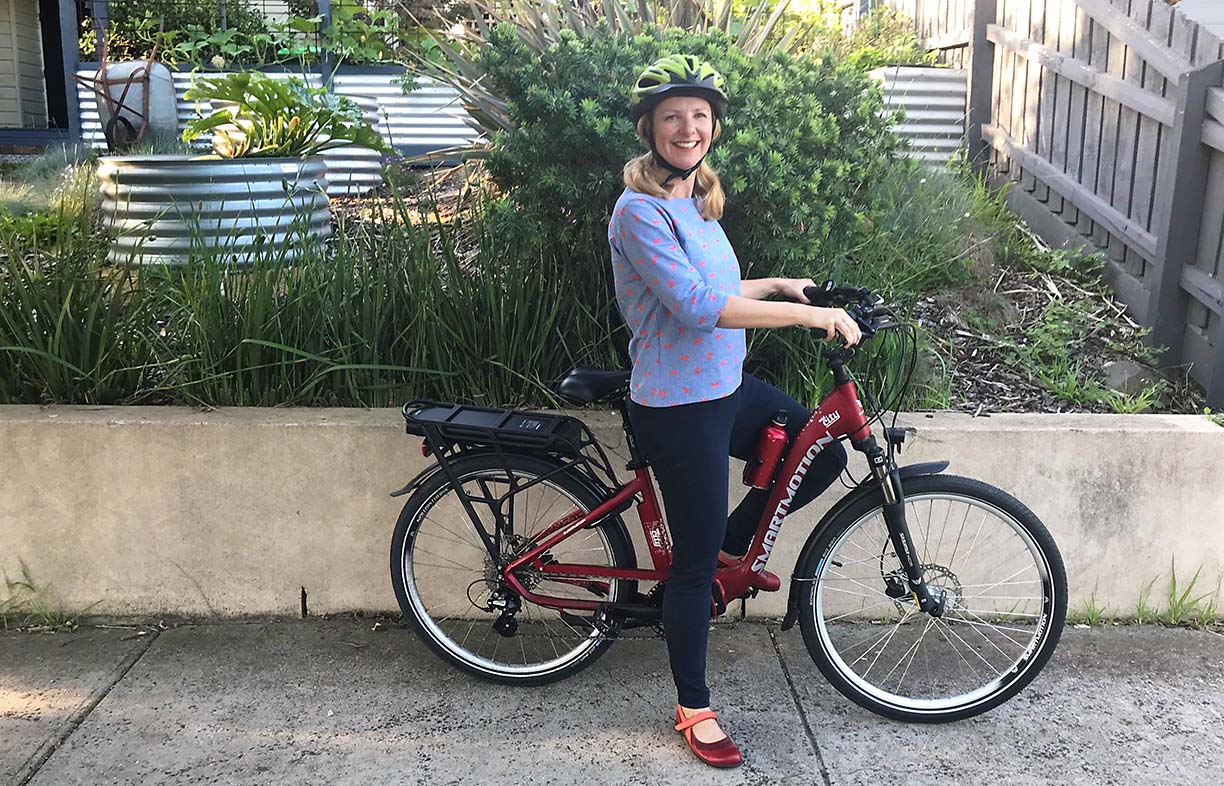
Deb Prentice’s e-bike purchase has got her back to bike commuting after a 15-year ‘post having children’ break. She’s a very new e-bike rider. She bought her e-bike in February this year after starting a new job which would have required two trains or a frustrating 13 km drive in peak-hour traffic, taking up to an hour. As someone committed to sustainability, the e-bike seemed a much better option.
And she’s loving it: “The bike route to my new job is mostly off-road, so there’s no traffic, no train delays and no coronavirus! And it only takes 40 to 50 minutes, less than the car or train commute.” She thought about using her old mountain bike, but didn’t think the bike or her fitness were up to it. The savings from not having to pay for public transport are good: “I did a rough calculation of the payback period on the purchase price compared to paying for public transport, and it was 2.5 years. I hope to be in this job for much longer than that!”
Using tips from friends who know a bit about bikes in general, and e-bikes in particular (and an earlier version of this guide), Deb drew up a list of questions and visited two stores, both of which specialise in e-bikes. She found great service at both and was able to test ride several bikes. “You could really tell the difference in grunt between different motors,” she notes. She liked a model with a Bosch motor, but found a cheaper bike that really suited her. “The bike I tried last felt the most comfortable to me, so I’d recommend that you keep trying bikes until you find one that suits you.”
Deb only took the bikes on short test rides, which “seemed enough to get a feel for them”, but she’d recommend longer rides if you can. Before committing to a purchase, Deb borrowed a friend’s five-year-old Gazelle e-bike and rode the route to work to see if it was something she’d really commit to. “Zipping along under the trees—I was hooked. The Gazelle was a great bike too. In the end I settled on the Smart Motion as the best for me for the price and feel.”
Deb has now had the bike for a month and she’s still loving it. One minor issue that’s emerged is the gears slipping occasionally which the bike shop is helping her with.
An unexpected boon has been the hand throttle, providing power up to 6 km/h. Such throttles are useful when pushing the bike along or, in Deb’s case, pushing it up the steep steps at the front of her house. “I also find the throttle great for taking off at lights; that extra acceleration makes me feel safer.”
Deb generally uses the lowest assistance level “to get some exercise”, but she really appreciates the extra power of the higher levels if she’s not feeling the best or is tired after work. “This bike has an extra strong power mode which I haven’t used much, but it’s good to know it’s there for big hills.”
Another thing that Deb has found useful is the detachable battery. “It’s useful if you need to charge it inside or, as happened last night, if you need to leave it at work. Although the bike gets locked up in a garage at work, I took the extra precaution of removing the battery and leaving it in the office—it’s a big part of the expense so I thought that would make it less attractive to steal!”
Like Angeline (in the previous case study), Deb is also a fan of the integrated lights: “They’re easier to click on and off than regular bike lights and one less thing for me to buy extra.” She also bought an attachment that means the step-through design can be carried on the bike rack on their car: “$35 well spent and easy to use.”
Deb charges the e-bike every night, something that the bike shop and user manual recommended, and it takes about three hours to top it up to full after her 26 km commute. “If you are going to commute, that’s a good question to ask: will the battery be plenty for there and back?”
Deb sums up her last thoughts: “Life can be quite monotonous when you work in the same place each day. Zooming off on my electric bike is a little bit of fun at the beginning and end of the working day. I feel more in control of my commute time and I’ve also found it helps me be a more polite rider, as slowing down and speeding up for pedestrians is not a chore. It gives me time to de-stress and time away from the phone. And it means I just might be able to keep up with my teenage sons! (Or maybe not.)“
E-bike evangelist
Bike: Gazelle Orange C7 Step Thru, Pedelec, 4 assistance levels, purchased April 2017, $4200
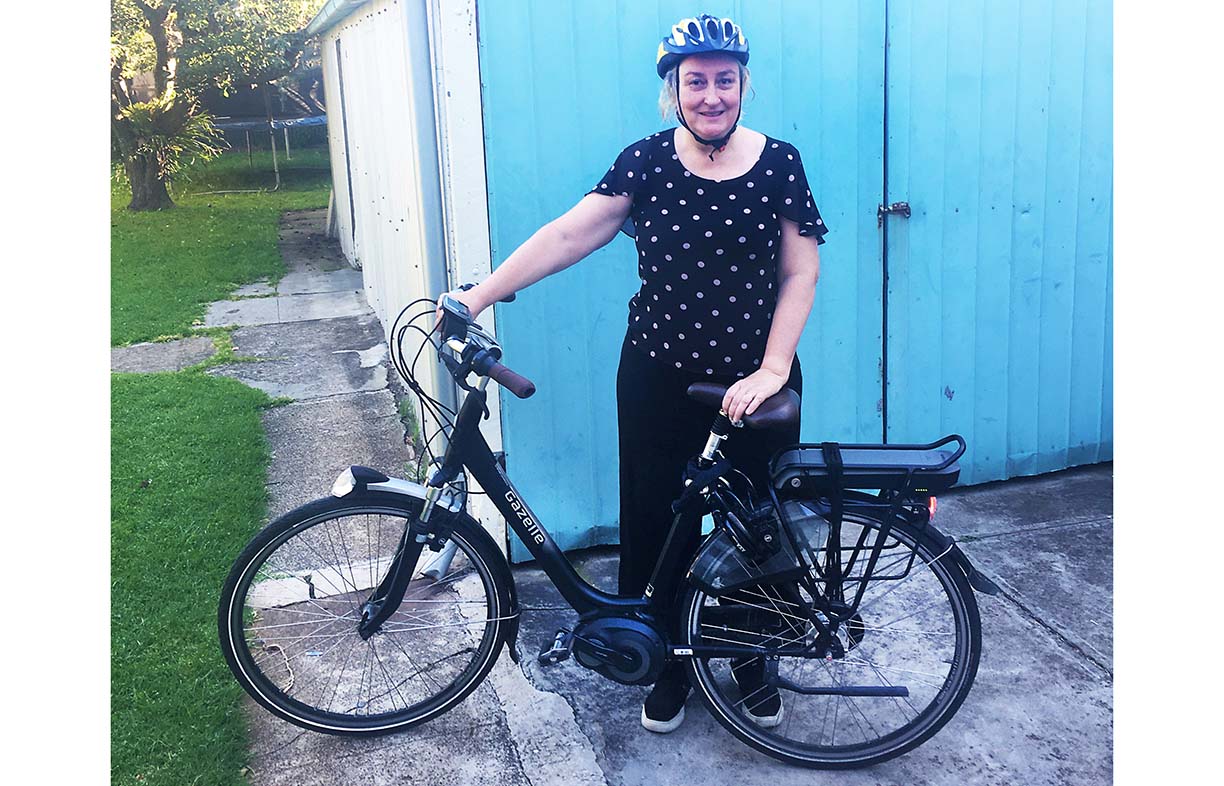
Lisa Jennings is happy to be described as an e-bike evangelist. Since she bought her e-bike in 2017, she’s used it pretty much every day to ride to work, and convinced around five friends and colleagues to do the same.
“It’s not too much to say that it’s changed my life,” she says. “I’m a bit fitter, I know exactly what time I’ll get to work, and I can always get a park.” The e-bike also means she doesn’t get too hot and sweaty on the ride, so she can start work immediately when she arrives.
Lisa bought the e-bike when her workplace was an inconvenient two modes of public transport away, or a long, frustrating car commute. That ride was about 18 km each way and a big bonus was fitting exercise into her long working day—she was working 60-hour weeks at the time.
She’s since changed jobs to a closer location, 10 km away, but has continued to enjoy the freedom and exercise from riding. She recommends good route planning: “My route is fantastic, three-quarters on bike paths and the other parts away from major traffic. Even when it’s raining, I’ll get on the bike because it’s more fun than the car or public transport.”
Another motivation, other than improving her commute, was to keep up with a fit husband and two teenage boys when they went on weekend rides on rail trails, for example. “On the flat, the others tend to cruise along at around 30 km/h and I still struggle to keep up as the assistance is limited to 25 km/h, but then on the hills I can catch them!”
She based her e-bike purchase on another colleague’s research, although she did try a couple of bikes before committing. She liked the Gazelle: “It seemed to have smoother gear changes and didn’t take as long for the motor to kick in.”
She’s taken the bike in for a service to the shop she bought it from once in the three years she’s had it (though she does recommend doing it every year). “When I took it in, the brakes were getting a bit weaker and the service helped it generally ride more smoothly.” Interestingly she hasn’t had a single puncture in that time.
She hasn’t noticed any decline in the battery, though she doesn’t monitor it closely. “It gets me about 70 km on the top assistance level, which is what I use most of the time.” She tops up the battery overnight. She’s run out of battery power once or twice and the result is a bike that’s almost too heavy to ride.
Lisa uses the in-built locking system to disable the bike at home and work, which stops it from being wheeled or ridden, as well as the more sturdy chain for the street. She concludes: “Why would you commute any other way?”
 Transport & travel
Transport & travel
Petroleum is fast becoming a dirty word
John Hermans explains the negatives of the petroleum industry.
Read more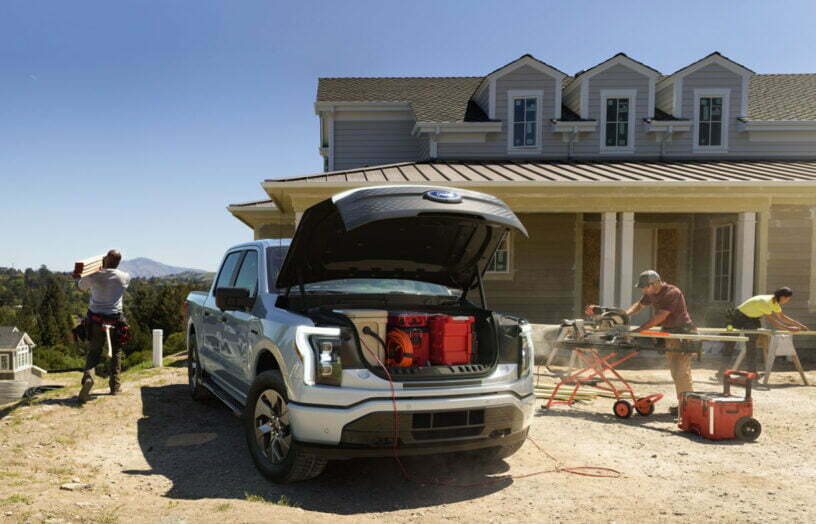 DIY
DIY
Bring on the electric ute
Bryce Gaton asks, will 2023 be the Australian ‘Year of the electric light commercial vehicle’?
Read more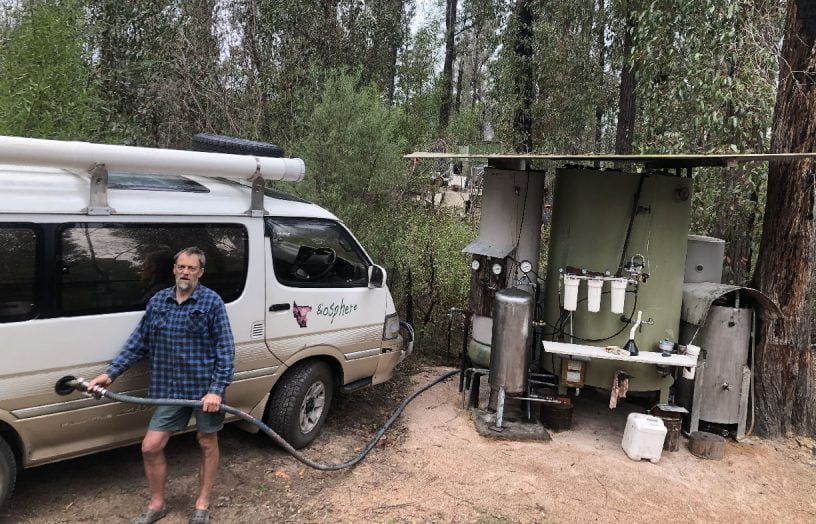 Transport & travel
Transport & travel
Biofuel vs battery
John Hermans gives his opinion on the best power source for electric vehicles.
Read more

